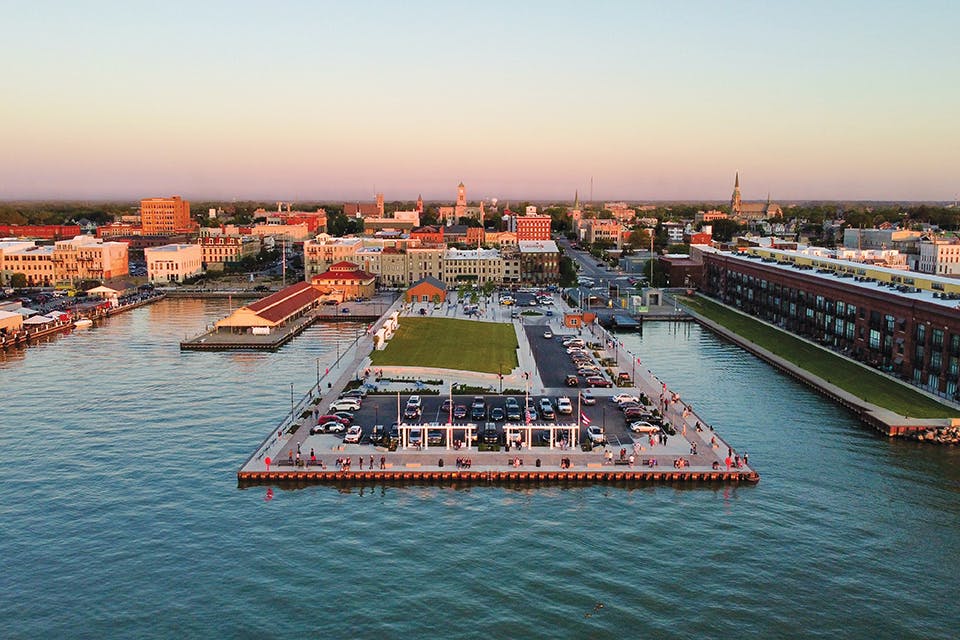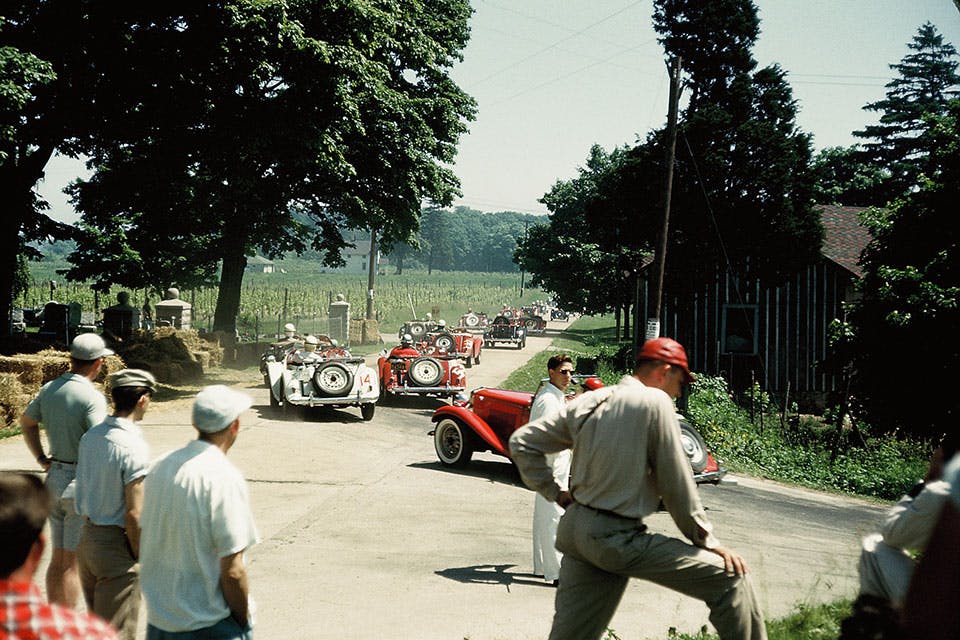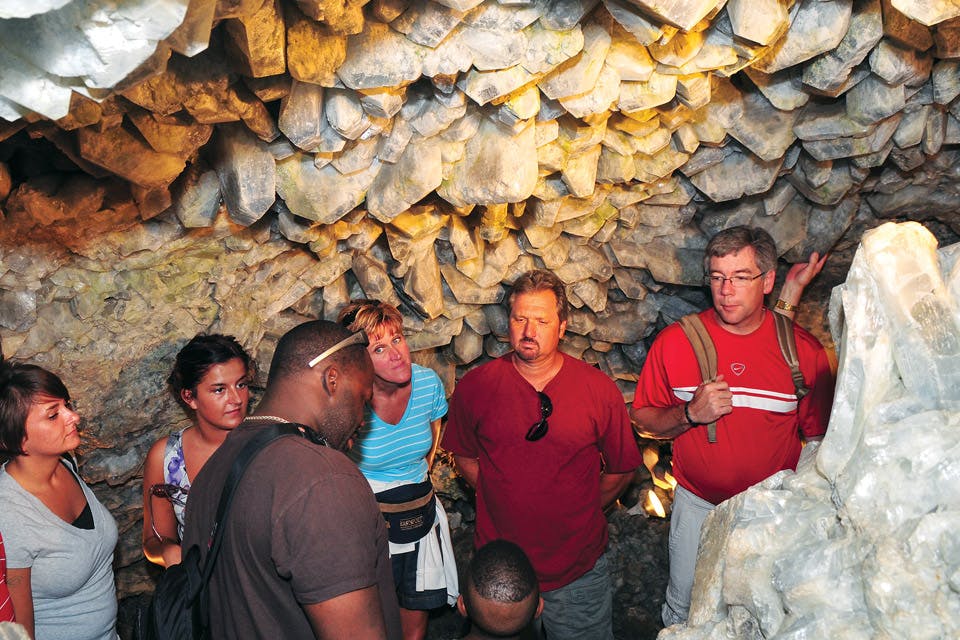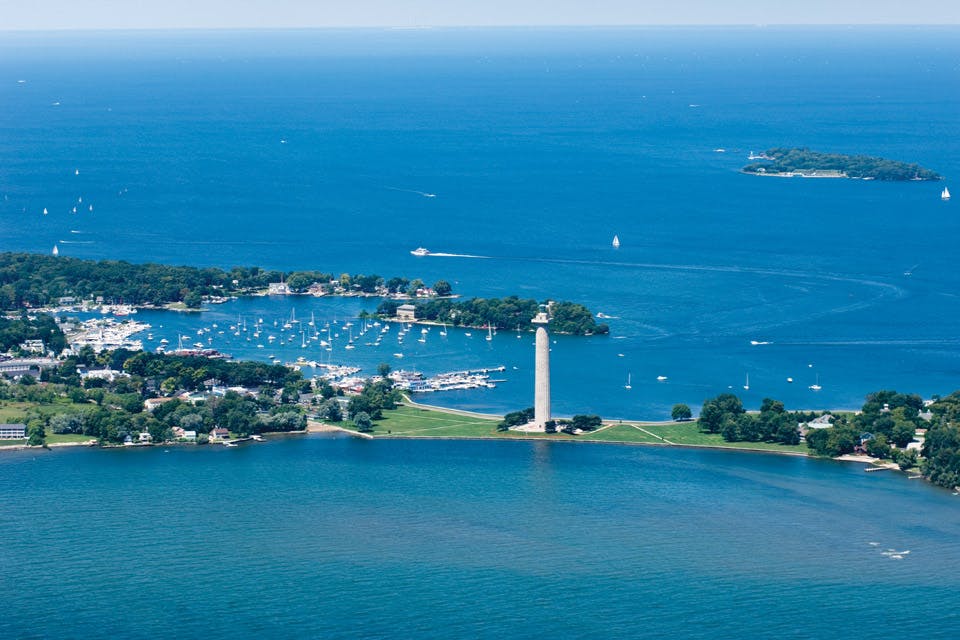Picture Perfect
Stunning vistas, natural areas and historical buildings make the islands region a perfect destination for shutterbugs.
June 2013 Issue
BY Lynne Thompson | Photo by Dan Feicht
June 2013 Issue
BY Lynne Thompson | Photo by Dan Feicht
If the Lake Erie Islands have one iconic landmark, the Perry’s Victory and International Peace Memorial is it. At 352 feet high, it is impossible to ignore. The pink-granite Doric column — a tribute to Commodore Oliver Hazard Perry’s victory over the British in the Battle of Lake Erie during the War of 1812 — rises from the isthmus of South Bass Island, towering over the surrounding archipelago. Shutter-happy visitors move from spot to spot on the 25-acre national park, photographing the 98-year-old Beaux Arts memorial from every possible angle. But the most breathtaking shots are taken from the observation deck 317 feet above the ground, according to park management assistant Steve Roberts.
“It provides great views of the western basin of Lake Erie,” he enthuses. “You’ll see the Lake Erie Islands. You’ll see the mainland of the United States, of Ohio and Michigan, as well as the islands of Canada and the mainland of Canada.”
The monument and its panoramic views are just one of the many picture-perfect attractions on the U.S. Lake Erie Islands and area mainland. Some, like the memorial, are man-made. Others are natural beauties that stunned native inhabitants long before entrepreneurs began developing the islands in the 1800s.
The sightseeing photo ops begin on the mainland at Marblehead Lighthouse at Marblehead Lighthouse State Park (dnr.state.oh.us/parks/Marblehead). The 65-foot, masonry-faced limestone structure, the original 50 feet of which opened in 1822, is the oldest lighthouse in continuous operation on the Great Lakes, as well as one of Lake Erie’s best-known and most-photographed landmarks.
“Regardless of the season or of the weather, you cannot take a bad picture of the lighthouse,” says park naturalist Dianne Rozak.
Although visitors can climb to the lighthouse’s observation deck on an escorted tour May 28–Aug. 30, landlubbers will find the surrounding grounds on Marblehead Peninsula provide excellent views of the lake and Sandusky Bay as well as Kelleys and South Bass islands. A detached keeper’s residence houses the lighthouse’s museum.
Aficionados will also want to check out South Bass Island Lighthouse (stonelab.osu.edu — check for tours and grounds access). Maggie Beckford, executive director of the Put-in-Bay Chamber of Commerce & Visitor Bureau, notes that the 116-year-old lighthouse, now owned by The Ohio State University, is actually a 45-foot tower attached to a two-story red-brick keeper’s house, a design that bucks traditional late 19th-century design.
“The best view of it, actually, is from the water,” she says.
More photo-worthy late-19th-century and early-20th-century architecture lines DeRivera Park, a shady 7-acre square, complete with gazebo and original working fountain, overlooking the harbor in downtown Put-in-Bay. Beckford singles out the 1870s Park Hotel and aptly named Round House Bar as well as buildings whose storefronts are now occupied by the Carriage House souvenir shop and Country House gift shop. Next to the park is Kimberly’s Carousel, a 1917 Allan Herschell merry-go-round that visitors can ride for a fee.
Nearby is the Doller House (419/285-3343, putinbaywinery.com, dollerhouse.com), a breathtaking yellow Italianate mansion completed in 1885 by island entrepreneur Valentine Doller. The Put-in-Bay Winery operates a tasting room open to the public — the majority of seating is on the front porch, two gazebos and grounds — and conducts $10-per-person “tasting tours” of the estate that include the painstakingly restored first floor and most of the outbuildings, including the last icehouse on the island. According to winery general manager Robby Morrow, the prime sipping spot is the front lawn facing Put-in-Bay Harbor.
”We’ll have groups of three or four couples that come to the island for the day just to sit in that front yard,” he says. “It’s so beautiful.”
A short water taxi ride away, on Ohio State University-owned Gibraltar Island, is another magnificent Italianate mansion: Cooke Castle (stonelab.osu.edu), the 15-room summer home built of Marblehead limestone by Philadelphia-based financier Jay Cooke in 1865. Kristin Stanford, education and outreach coordinator for the Ohio Sea Grant College Program and OSU’s Stone Laboratory, says the laboratory offers a walking tour of the 6-1/2-acre island every Wednesday, June 19–Aug. 14, that includes a stroll on the grounds of the Sandusky native’s warm-weather retreat.
“We spent quite a bit of money over the past 10 years renovating the outside of it,” she explains. “But the inside is still a little bit rough — the upstairs is actually unsafe.” The unfurnished first floor is open to the public during Stone Laboratory’s annual open house, this year scheduled for Sept. 7.
Despite over 175 years of commercial and residential development, there is still plenty of natural beauty to appreciate in the islands region. Steve Riddle, assistant manager of the Lake Erie Islands state parks, recommends heading to South Bass Island State Park (866/644-6727 for campsite reservations, dnr.state.oh.us/parks/parks/lakeerie), where the white cliffs provide an ideal place to watch the sun set over western Lake Erie. One of the biggest tourist attractions on less-developed Kelleys Island is a large tract of glacial grooves in Kelleys Island State Park (866/644-6727 for campsite reservations, dnr.state.oh.us/parks/parks/lakeerie), Riddle notes that the depressions — carved in the limestone bedrock by the weight of massive ice sheets as they moved south from Canada during the Glacial Period — measure an amazing 15 feet deep and 30 feet wide.
“There are all different kinds of fossils embedded in the limestone, different plants and things we don’t really see today,” he adds.
But the park is also endowed with a half-mile-long natural-sand beach — a good place to see the sun rise, Riddle says, and a nearly pristine wetland known as the North Pond State Nature Preserve. Riddle describes its 30 acres as “a birder’s paradise,” one with a boardwalk that extends over the marsh to an elevated platform. During the spring and fall, the preserve is alive with hundreds of species of migrating songbirds and dozens of waterfowl species. According to the park website, there are also nesting pairs of bald eagles in the area. Other scenic areas in the park include Horseshoe Lake, known for its abundance of plant and aquatic life, and the East Quarry, a remnant of the massive limestone-extraction industry that once flourished on the island.
One of the best uses of that locally quarried limestone was the construction of Kelley Mansion (211 E. Lake Shore Dr.), a private residence originally completed in 1867 for Addison Kelley, son of onetime Kelleys Island co-owner and developer Datus Kelley. Visitors looking for a charming place they can actually check into can head down the road to A Water’s Edge Retreat (watersedgeretreat.com), an antique-filled bed-and-breakfast modeled after a late-19th-century Victorian farmhouse in Cape May, New Jersey. Like the original, the house has a turquoise-and-pink paint job, gingerbread trim and wraparound porch.
On Middle Bass Island, one of the most photogenic places to bed down is the Middle Bass Inn (middlebassinn.com), yet another Italianate residence built at the end of the Civil War. Co-owner Ralph Renninger boasts that guests can see five islands from the front porch of his waterfront bed-and-breakfast.
“The sunsets are fantastic,” he adds.
Middle Bass Island East Point Preserve (ohiodnr.com, lakeerieislandsbsc.com), a 12-acre property owned by the Put-in-Bay Township Park District with a combination of diverse habitats — natural beach, hardwood forest, grasslands — is a prime birding spot. “It’s on a private road, so it’s accessible only by foot or by kayak,” says Lisa Brohl, a member of the park district’s board. Another great location for birders and other wildlife watchers, the 20-acre Kuehnle State Wildlife Area (614/265-6300, ohiodnr.com), is distinguished by its location on a double tombolo, which Brohl describes as marsh sandwiched between two narrow strips of shoreline.
“The island is very narrow at that point — the marsh is just separated from Lake Erie by these two gravel bars,” she explains. But the most-photographed spot on Middle Bass is arguably the Gothic castellated structure that housed the former Lonz Winery until a terrace collapse closed the place in July 2000. Beckford notes that the winery complex is testament to the islands’ history of grape-growing and winemaking. “The Bass Islands — South, Middle and North — were called the Wine Islands back in the late 1800s, early 1900s,” she says. The Lonz property is now part of Middle Bass Island State Park (dnr.state.oh.us/parks/middlebass). Public access is restricted to walking the grounds.
The most-anticipated sight — in 2013, at least — is a reenactment of the Battle of Lake Erie on Sept. 2, among several activities scheduled to mark the 200th anniversary of the naval engagement. If the reenactment is staged in the original battle location — approximately eight miles northwest of Perry’s Victory and International Peace Memorial (nps.gov/pevi) between Rattlesnake and West Sister islands — one of the best vantage points will be the monument’s observation deck. Roberts says the very sight of the watery battlefield evokes images in the history buff’s mind, even when there’s not a tall ship in sight.
“You can imagine that day in September 1813 when the Battle of Lake Erie took place, picture where the American and British fleets would have met out on the lake,” he says.
Related Articles

Explore these Lake Erie Shore Towns and Islands
Ohio’s Lake Erie islands and our state’s northwestern shoreline are full of history, nature and great lakeside towns to explore this time of year. READ MORE >>

The History of the Put-in-Bay Road Race
During the 1950s, this annual event brought sports car owners to South Bass Island to face off on a 3.1-mile course set up on city streets. READ MORE >>

Crystal Cave, Put-in-Bay
Heineman Winery offered tours of what it bills as the world’s largest geode to stay afloat during Prohibition. You can still check it out today. READ MORE >>


